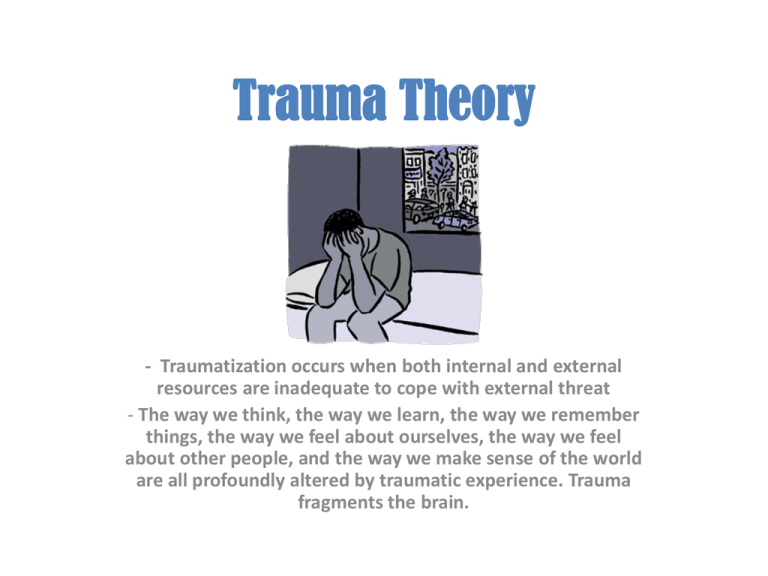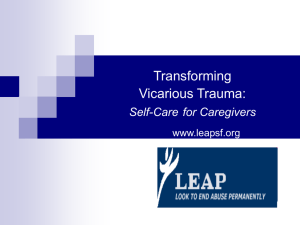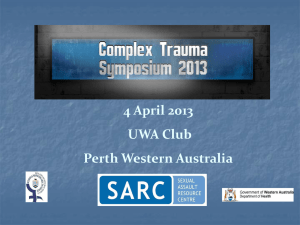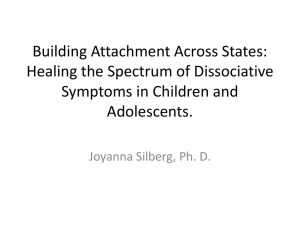
Trauma Theory
- Traumatization occurs when both internal and external
resources are inadequate to cope with external threat
- The way we think, the way we learn, the way we remember
things, the way we feel about ourselves, the way we feel
about other people, and the way we make sense of the world
are all profoundly altered by traumatic experience. Trauma
fragments the brain.
Fight or Flight Response
• Biological mechanism to protect from harm
• Happens whenever we perceive that we are in danger
• Each episode of danger connects to every other episode
in our minds – the more danger we are exposed to, the
more sensitive we are to danger
• What can we do? We must create a safe environment to
counteract long-term effects of trauma
Learned Helplessness
• In traumatic situations, the victim is helpless
• Repeated helplessness changes our basic
neurochemistry that allows us to self-motivate out of
dangerous situations. In other words, we give up
• What can we do? Intervention must focus on
empowerment while avoiding future experiences of
helplessness
Loss of “Volume Control”
• We respond to stimulus based on the threat that stimulus presents
• Trauma destabilizes our internal system of arousal – i.e. our
“volume control” that we normally have over our emotions,
especially fear.
• Instead, traumatized people have only an “on/off” switch
• Substance use (drugs, alcohol, sex, eating, self-harm) to calm and
control internal states
• What can we do? Blaming and punishment for destructive coping
mechanisms is counterproductive. If folks are going to stop using
destructive coping mechanisms, they must be offered better
substitutes and a safe environment for cultivating those new coping
skills
Thinking Under Stress – Action Not
Thought
• Our capacity to think clearly is impaired when we are stressed
• When in danger, we are physiologically geared to respond with
action, and do not have time for complicated mental processing
• Decisions tend to be based on impulse and a need to self-protect
• What can we do? Intervention efforts must focus on reducing stress
and allowing survivors time and space to mentally process trauma
and to calm the stress-induced hypervigilance that it creates
Remembering Under Stress
•
•
•
•
•
•
Our way of remembering things, processing new memories, and accessing old
memories is dramatically changed under stress
When we are overwhelmed with fear, we lose the capacity for speech, and often
the capacity to put words to our experience.
Without words, the mind shifts to a more visceral form of memory – visual,
auditory, olfactory, and kinesthetic images, physical sensations, and feelings
Flashback: intrusive re-experiencing of those unverbalized memories – not really
“remembering,” but rather “reliving”
Without words, the traumatic events of the past are often experienced as being in
the present. Words allow us to put the past where it belongs – in the past.
How can we do? The implication of this information is that we must provide an
abundance of opportunities for survivors of trauma to talk and talk and talk! We
also must provide programs that focus on nonverbal expression – art, music,
movement, etc.
Emotions & Trauma - Dissociation
• Dissociation “safety valve”
• Dissociation is a ‘disruption in the usually integrated functions of
consciousness, memory, identity, or perception of the environment’ – it is
splitting off experience from our feelings about that experience
• Repetitive T & D leads to emotional numbing & avoidance
• Avoidance symptoms (dissociation) combined with intrusive symptoms
(flashbacks) = PTSD and hyperarousal
• What can we do? Recognize that these unhealthy coping mechanisms are
effective and often necessary in the short-term, but are detrimental in the
long term. Again, we must create an environment where survivors can
process the past, and gain new, healthier coping mechanisms for the future
Endorphins & Stress – Addiction to
Trauma
• Endorphins calm anxiety, improve our mood, and decrease aggression, but
they are also analgesics related to morphine and heroin
• People exposed to prolonged stress and trauma can become “addicted” to
their own elevated endorphin levels – creating a situation where they only
feel calm while under stress, and feel irritable and hyperaroused when
stress is relieved
• Trauma survivors may resort to behavior that triggers those same
endorphins: self-mutilation, risk-taking behavior, compulsive sexuality,
involvement in violent activity, binging and purging, and drug addiction
• What can we do? Intervention strategies must focus on helping people
‘detox’ from behavioral and substance based addictions – again by providing
an environment that is calm and safe, and by educating folks about the
effects of trauma on the brain and body
Trauma Bonding
• Trauma bonding occurs when strong emotional ties develop
between two persons where one person intermittently harasses,
beats, threatens, abuses, or intimidates the other.
• Imbalance of power
• Abuse is sporadic in nature
• Victim engages in denial of the abuse and often dissociates for
emotional self-protection – an overloaded system causes them to
distort reality
• What can we do? Survivors need direct experience engaging in
relationships that are not abusive or punitive
Victim to Victimizer
• A victim is helpless and powerless- this is part of the trauma
• Some trauma survivors “reclaim” their power by assuming
the power of a person who has hurt them, becoming
someone who terrorizes and abuses others
• This abusive behavior can reduce anxiety and provide
excitement – these two effects can be habit forming
• Cultural Influence and traditional gender narratives
– Masculinity: does not allow for helplessness. You cannot be a
victim and be male
– Feminity: not only allows for, but encourages helplessness
So What?
• Frame violence not as an individual problem, but a symptom of the
breakdown of social order – a community social problem
• “What’s happened to you?” instead of “What’s wrong with you?”
• When people receive understanding, it enables them to begin to
understand themselves and make positive changes
• Create safety – physical, psychological, social, and moral
– Safety involves not just prohibitions against violence to others, but also selfdestruction (substance use, self harm)
– In a community the violence one does to themselves and their body effects
others
– The real challenge is how to establish and maintain safety without invoking
punitive, violent, and restrictive measures that add to the problem










